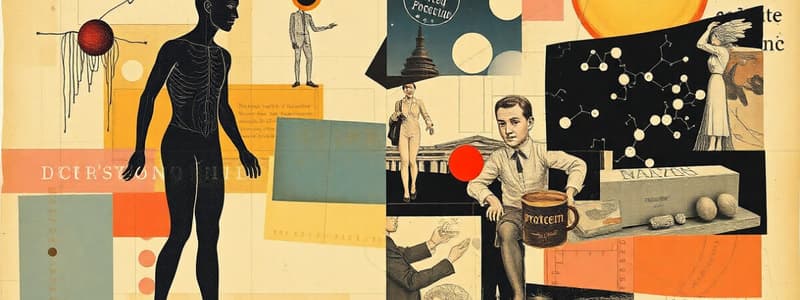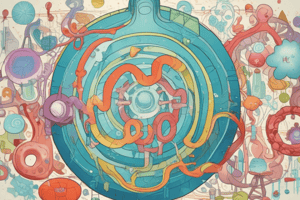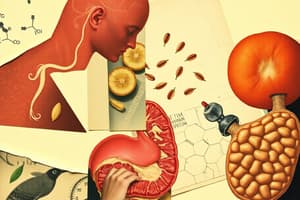Podcast
Questions and Answers
What process occurs in the liver during the use of proteins for energy?
What process occurs in the liver during the use of proteins for energy?
- Ureogenesis, directly excreting amino acids.
- Deamination, removing an amino group from an amino acid. (correct)
- Transamination, transferring amino groups to synthesize new amino acids.
- Ketogenesis, converting amino acids into ketone bodies for direct energy use.
Which of the following is the primary mechanism by which amino acids enter cells?
Which of the following is the primary mechanism by which amino acids enter cells?
- Active transport or facilitated diffusion. (correct)
- Endocytosis, engulfing amino acids within vesicles.
- Osmosis, driven by water potential differences.
- Simple diffusion, moving down a concentration gradient without assistance.
What is the role of aminotransferases in protein metabolism?
What is the role of aminotransferases in protein metabolism?
- They facilitate the transport of amino acids across cell membranes.
- They catalyze the synthesis of urea from ammonia.
- They regulate the hormonal control of protein deposition in muscles
- They are responsible for deamination of amino acids. (correct)
Why is the conversion of ammonia to urea important?
Why is the conversion of ammonia to urea important?
Which hormone increases the breakdown of extrahepatic proteins, leading to an increased availability of amino acids?
Which hormone increases the breakdown of extrahepatic proteins, leading to an increased availability of amino acids?
What best describes the role of cortisol in gluconeogenesis?
What best describes the role of cortisol in gluconeogenesis?
What is the primary function of chemiosmosis in the context of energy production?
What is the primary function of chemiosmosis in the context of energy production?
What happens to dietary triglycerides after absorption in the intestines?
What happens to dietary triglycerides after absorption in the intestines?
Why is anaerobic glycolysis considered less efficient?
Why is anaerobic glycolysis considered less efficient?
What is the generalized formula for a fatty acid?
What is the generalized formula for a fatty acid?
Which intermolecular force would increase water solubility the most?
Which intermolecular force would increase water solubility the most?
A solution contains more solute than it can theoretically hold at a given temperature. What term describes this solution?
A solution contains more solute than it can theoretically hold at a given temperature. What term describes this solution?
Two liquids mix in all proportions. What term characterizes this scenario?
Two liquids mix in all proportions. What term characterizes this scenario?
Based on the principle of 'like dissolves like,' which solvent would be most effective for dissolving a nonpolar solute?
Based on the principle of 'like dissolves like,' which solvent would be most effective for dissolving a nonpolar solute?
If the temperature of a liquid solvent increases, what happens to the solubility of a gas dissolved within it?
If the temperature of a liquid solvent increases, what happens to the solubility of a gas dissolved within it?
Why does increasing the temperature of a liquid generally decrease the solubility of a dissolved gas?
Why does increasing the temperature of a liquid generally decrease the solubility of a dissolved gas?
A patient is hypothermic after receiving a volatile anesthetic. What effect does the patient's low body temperature have on the anesthetic's solubility in their blood?
A patient is hypothermic after receiving a volatile anesthetic. What effect does the patient's low body temperature have on the anesthetic's solubility in their blood?
Why is molality not dependent on temperature?
Why is molality not dependent on temperature?
Which of the following is a disadvantage of using molality in analysis?
Which of the following is a disadvantage of using molality in analysis?
What additional information is needed to convert between molarity and molality?
What additional information is needed to convert between molarity and molality?
In a clinical setting, which concentration unit is commonly used when measuring a volume of medicine in a syringe?
In a clinical setting, which concentration unit is commonly used when measuring a volume of medicine in a syringe?
How is percent by weight to volume (% w/v) defined?
How is percent by weight to volume (% w/v) defined?
Why is percent by volume (% v/v) rarely used in an analytical laboratory?
Why is percent by volume (% v/v) rarely used in an analytical laboratory?
What is an equivalent (Eq) analogous to?
What is an equivalent (Eq) analogous to?
Which of the following is true regarding normality?
Which of the following is true regarding normality?
Flashcards
Chemiosmosis
Chemiosmosis
The process of using a proton gradient to synthesize ATP.
ATP Efficiency
ATP Efficiency
Total ATP produced from glucose breakdown is 38 ATP, about 66% efficient.
Anaerobic Glycolysis
Anaerobic Glycolysis
Glucose metabolism without oxygen, producing lactic acid.
Gluconeogenesis
Gluconeogenesis
Signup and view all the flashcards
Triglycerides
Triglycerides
Signup and view all the flashcards
Transport of Amino Acids
Transport of Amino Acids
Signup and view all the flashcards
Major Plasma Proteins
Major Plasma Proteins
Signup and view all the flashcards
Deamination
Deamination
Signup and view all the flashcards
Urea Formation
Urea Formation
Signup and view all the flashcards
Hormonal Regulation of Protein Metabolism
Hormonal Regulation of Protein Metabolism
Signup and view all the flashcards
Molality
Molality
Signup and view all the flashcards
Molarity
Molarity
Signup and view all the flashcards
Percent by weight to volume (%w/v)
Percent by weight to volume (%w/v)
Signup and view all the flashcards
Percent by weight (%w/w)
Percent by weight (%w/w)
Signup and view all the flashcards
Percent by volume (%v/v)
Percent by volume (%v/v)
Signup and view all the flashcards
Normality
Normality
Signup and view all the flashcards
Equivalent (Eq)
Equivalent (Eq)
Signup and view all the flashcards
Parts per million (ppm)
Parts per million (ppm)
Signup and view all the flashcards
Water Solubility
Water Solubility
Signup and view all the flashcards
Saturated Solution
Saturated Solution
Signup and view all the flashcards
Supersaturated Solution
Supersaturated Solution
Signup and view all the flashcards
Miscible Liquids
Miscible Liquids
Signup and view all the flashcards
Like Dissolves Like
Like Dissolves Like
Signup and view all the flashcards
Effect of Temperature on Solubility
Effect of Temperature on Solubility
Signup and view all the flashcards
Kinetic Energy
Kinetic Energy
Signup and view all the flashcards
Study Notes
Chemical Reactions and Metabolism
- Chemical reactions are the processes that allow cells to survive.
- Most chemical reactions in cells involve taking energy from food and making it available for bodily processes.
- Two types of metabolism exist: anabolism (synthesis) and catabolism (breakdown).
Carbohydrate Metabolism and ATP Formation
- Carbohydrate metabolism (chapter 69) is the process that breaks down carbohydrates to form ATP.
- Fructose and galactose are rapidly converted to glucose in the liver after absorption.
- Glucose (C6H12O6) undergoes a series of catabolic and anabolic pathways for energy production and storage.
Metabolism
- Metabolism comprises various chemical processes that sustain cellular life.
- Anabolism builds complex molecules while catabolism breaks down complex molecules. Anabolism, Catabolism
- Energy production involves processes like protein, carbohydrate, and fat oxidation.
- Energy utilization consists of essential cellular processes such as active transport, muscle contraction, synthesis, and growth.
Reactions Worth Knowing
- Dehydration synthesis is an anabolic reaction, forming covalent bonds between monomers and releasing water (H₂O).
- Hydrolysis is a catabolic reaction. It involves breaking down polymers into monomers by adding water (H₂O).
Energy Foods
- Fats, carbohydrates, and proteins can be oxidized for energy production, resulting in large amounts of energy.
- Phosphate bonds are high-energy bonds, crucial in ATP production.
- Aerobic metabolism generates significantly more ATP than anaerobic metabolism.
Coupled Reactions
- Chemical energy from food must be released slowly for cellular processes.
- This slow release of energy is linked to cellular activities such as membrane pumps, protein synthesis, and muscle contractions.
ATP - Adenosine Triphosphate
- ATP is an intermediate compound facilitating numerous coupled reactions within cells.
- ATP stores a significant amount of energy, approximately 12,000 calories per mole in the body.
- ATP's structure includes adenine, ribose, and three phosphate groups.
Glucose (Dextrose)
- After intestinal absorption, much of the fructose and galactose are rapidly converted to glucose in the liver.
- Glucose serves as a primary pathway for carbohydrate transport into cells.
Transport of Glucose Through Cell Membrane
- Glucose cannot directly diffuse through cell membranes.
- Active co-transport or facilitated diffusion, requiring a carrier protein, is essential.
- Insulin plays a crucial role in facilitating this process.
Phosphorylation
- Upon entering cells, glucose combines with a phosphate radical to form glucose-6-phosphate.
- Glucose-6-phosphate can be immediately utilized for cellular energy or stored as glycogen in the liver and muscles.
Glycogenesis
- Glycogenesis is the process of glycogen formation, a storage form of glucose (starch).
Glycogenolysis
- Glycogenolysis involves breaking down glycogen into glucose for energy.
- Phosphorylase (enzyme) regulates this process and is activated by hormones like epinephrine and glucagon.
Release of Energy from Glucose
- Glucose energy release involves glycolysis, the citric acid cycle, and the electron transport chain, ultimately producing ATP.
Glycolytic Pathway
- Glucose releases 686,000 calories that only need 12,000 calories to produce 1 mole of ATP.
- Enzymes gradually break down the glucose in smaller steps to capture energy in ATP.
- Each glucose molecule potentially yields 38 ATP.
Glycolysis
- Glycolysis, a crucial energy-releasing process, breaks down glucose into pyruvic acid.
- This process spans 10 steps, occurs in the cytoplasm, and produces ATP.
- Efficiency for ATP formation from glucose is ~43%.
Citric Acid Cycle (Krebs Cycle)
- The citric acid cycle (Krebs Cycle) takes place in the mitochondria.
- Acetyl CoA combines with oxaloacetic acid to form citric acid, the first product.
- After the cyclical reactions 24 hydrogen atoms are released.
- The cycle produces 2 ATP per glucose molecule and liberates CO2 and hydrogen atoms.
Oxidative Phosphorylation
- Oxidative phosphorylation is a crucial process that requires oxygen.
- In mitochondria, NADH is oxidized, releasing electrons that move through the electron transport chain.
- This process establishes a proton gradient, driving ATP production via chemiosmosis.
- A combination of the electron transport chain and chemiosmosis equate to oxidative phosphorylation.
Summary of ATP Formation
- Glycolysis produces 4 ATP, using 2 ATP so net gain is 2 ATP.
- Citric Acid Cycle contributes 2 ATP.
- Electron Transport yields 34 ATP.
- Total ATP production is 38 per glucose molecule, consuming 66% of initial potential energy.
Anaerobic Glycolysis
- Anaerobic glycolysis produces lactic acid as a byproduct when oxygen is scarce.
- Measuring lactate in the OR gives insights into cellular oxygen use.
- Lactic acid can be reconverted to glucose or energy when oxygen is available.
Storage of Glucose
- Glycogen stores are filled first, followed by fat storage for excess glucose.
Gluconeogenesis
- Gluconeogenesis is responsible for converting fats and proteins into glucose when glucose is unavailable.
- Low blood glucose triggers the release of cortisol from the adrenal cortex, causing protein breakdown into amino acids.
- This protein breakdown is utilized by the liver for gluconeogenesis. This is a catabolic process.
Lipid Metabolism (chapter 69)
- Lipids (fats) are the primary energy-storage molecules.
- Triglycerides, phospholipids, and cholesterol are examples of lipids.
Fatty Acids
- Fatty acids are simple, long-chain hydrocarbons with a carboxyl group (-COOH).
- Palmitic acid is a common example of a saturated fatty acid.
Triglycerides
- Triglycerides consist of glycerol backbone bonded to three fatty acid molecules.
- Triglycerides are the primary storage form of fat.
Absorption of Fats
- Dietary triglycerides are broken down into monoglycerides and fatty acids within the intestines.
- Chylomicrons, newly packaged triglycerides, are absorbed into the lymphatic system.
- Blood plasma becomes turbid within 1 hour post ingestion of high-fat meals.
Uptake into Cells
- Lipoprotein lipase in capillary endothelium hydrolyzes triglycerides into fatty acids and glycerol.
- Fatty acids then diffuse into cells to be resynthesized into triglycerides for storage.
Transport through Body
- Hydrolyzed triglycerides are converted into fatty acids and glycerol.
- This combination combines with albumin in the blood, forming free fatty acids.
Fat Deposits
- Fat deposits, or adipose tissue, store triglycerides.
- Fat cells are primarily composed of triglycerides.
- Adipose tissues are 80–95% full of triglycerides.
Use of Triglycerides for Energy
- Triglycerides are hydrolyzed into fatty acids and glycerol to obtain energy.
- Glycerol is converted into glycerol-3-phosphate entering the glycolytic pathway.
- Oxidation of fatty acids occurs within the mitochondria, generating substantial amounts of ATP.
Beta-Oxidation
- Fatty acids are converted into acetyl-CoA through beta-oxidation.
- Acetyl-CoA enters the citric acid cycle, similar to carbohydrate metabolism.
- Beta-oxidation of fatty acids yields considerable ATP; a single stearic acid molecule produces a net gain of 146 ATP molecules.
Ketosis
- Ketosis occurs when carbohydrates are scarce, leading to fat oxidation for energy.
- Ketone bodies, such as acetoacetic acid and β-hydroxybutyric acid, are produced.
- Starvation, diabetes mellitus, and high-fat, low-carbohydrate diets can trigger ketosis.
Regulation of Fat Utilization
- Epinephrine and norepinephrine stimulate triglyceride lipase, increasing free fatty acid (FFA) release.
- Elevated corticotropin and glucocorticoids and decreased insulin levels promote FFA use.
Phospholipids
- Phospholipids consist of fatty acid and phosphoric acid radicals along with a nitrogenous base.
- Lecithins, cephalins, and sphingomyelins are types of phospholipids.
Uses of Phospholipids
- Phospholipids are critical components of cell membranes and lipoproteins.
- They are involved in blood clotting (thromboplastin).
- Sphingomyelin is a component of myelin sheaths.
Uses of Cholesterol
- Cholesterol forms cholic acid in the liver for fat digestion.
- It's a precursor for steroid hormones.
- It is a vital component of the skin's waterproof barrier.
Atherosclerosis
- Atherosclerosis involves fatty lesions (plaques) in the large arteries.
- Similar to arteriosclerosis, this involves thickening and stiffening of vessel walls.
- Connective tissue growth in plaques stiffens vessel walls.
- Plaques can form blockages, causing vessel rupture.
Factors that Lead to Atherosclerosis
- Physical inactivity, obesity, family history, diabetes, high blood pressure, high cholesterol levels and smoking are risk factors for atherosclerosis.
Prevention of Atherosclerosis
- Primarily a healthy diet emphasizing low-fat intake.
- Other preventive measures include smoking cessation, exercise, maintaining healthy blood pressure and blood sugar control.
Protein Metabolism (Chapter 70)
- Proteins form 3/4 of the body's solids.
- Proteins are composed of amino acids (20 types).
- Peptide bonds link amino acids, forming protein chains.
Regulatory Proteins
- Regulatory proteins transmit signals within cells, often via G-protein-coupled receptors.
- Ligands, chemical signaling molecules, bind to receptors.
- Binding to receptors triggers subsequent events that are known as downstream or second-messenger events.
Transport of Amino Acids
- Digestion in the gastrointestinal tract converts proteins to amino acids.
- Absorption and transport of amino acids within the cells is usually facilitated or active.
- Excessive amino acid concentrations may be lost into urine.
Storage of Amino Acids
- Amino acids are immediately incorporated into new proteins upon entering cells.
- Low blood amino acid levels trigger their release to restore the supply.
- A balance between amino acids and proteins exists.
Major Plasma Proteins
- Albumin is crucial for colloidal osmotic pressure.
- Globulins are involved in enzymatic and immune functions.
- Fibrinogen is essential for coagulation.
Dietary Amino Acids
- 10 essential amino acids are not synthesized by the body; they must be ingested.
- 10 nonessential amino acids can be synthesized.
Use of Proteins for Energy
- Protein energy utilization occurs primarily in the liver.
- Deamination, removing amino groups (-NH2) from amino acids, is the initial step.
- Enzymes like aminotransferases catalyze deamination.
Urea
- Ammonia, a byproduct of deamination, is converted to urea in the liver.
- Urea is then excreted by the kidneys.
Oxidation of Deaminated Amino Acids
- The resulting keto acid is further degraded into substances entering the citric acid cycle.
- These substances are oxidized to produce ATP; this process involves entering the citric acid cycle.
- This process is known as ketogenesis.
Obligatory Degradation of Proteins
- 20-30 grams of protein is degraded and oxidized daily, irrespective of dietary intake.
- Insufficient protein intake leads to starvation.
- Carbohydrates can spare protein use as an energy source.
Hormonal Regulation of Protein Metabolism
- Hormones, including growth hormone, insulin, glucocorticoids, testosterone, and thyroxine, influence protein metabolism.
- These hormones impact protein synthesis, transport, breakdown, and deposition in tissues.
Aqueous Solutions & Concentrations; Solubility, Diffusion, and Osmosis
- A solution is a homogenous mixture where a solute (dissolved substance) is uniformly dispersed in a solvent (dispersing medium)
- Molality is the number of moles of solute per kilogram of the solvent.
- Molality is temperature independent, unlike molarity (moles per liter).
Percent
- Percent concentration (% w/v) specifies grams of solute per 100 mL of solution.
- This is frequently used in medical settings for solutions and treatments, particularly in syringes.
- Percent by weight to volume (% w/w) describes the relation for example of topical creams, where relating percent by weight to volume necessitates using the solution's density.
Solubility
- Solubility describes the amount of solute that can dissolve in a given solvent at a specific temperature.
- Factors affecting solubility include intermolecular interactions, temperature, and pressure.
- "Like dissolves like" is a general principle, meaning polar substances usually dissolve in polar solvents.
Solubility (cont.)
- A saturated solution contains the maximum solute.
- A supersaturated solution has more dissolved solute than a saturated solution allows.
- Precipitation may occur in supersaturated solutions, returning the system to a saturated state.
- Miscible liquids dissolve in all proportions.
Effect of Temperature on Solubility
- Generally, increased temperature increases the solubility of solid and liquid solutes in a given solvent, except for gases.
- Increased temperature decreases gas solubility in liquids.
- The kinetic energy of dissolved gas molecules increases with temperature, leading to escape into the gas phase.
Energy Changes & the Solution Process
- Dissolving a solute in a solvent often involves an energy change, potentially leading to significant changes in the solution's temperature.
- Heat of solution is the energy change when 1 mole of solute is dissolved in a particular solvent.
- The heat of solution is affected by the energy required to break apart solute molecules and the energy released when solvent-solute bonds form.
- Exothermic solutions will release heat and get warmer.
- Endothermic solutions will absorb heat and get colder.
Colligative Properties of Solutions
- Colligative properties of solutions depend on the concentration of solute particles, regardless of the solute's nature.
- These properties include vapor pressure lowering, boiling point elevation, freezing point depression, and osmotic pressure.
Diffusion
- Diffusion is the net movement of molecules from a higher concentration to a lower concentration.
- Diffusion rates are influenced by temperature, kinetic energy, membrane properties, and molecular mass.
- smaller molecules diffuse faster than larger ones.
Graham's Law
- Graham's law describes the relationship between gas diffusion rate and molecular weight.
- The simpler formula for effusion rate (r) is r =1/√mw, where mw = molecular weight.
Permeable/Semipermeable Membrane
- Diffusion can occur readily through open space or specialized permeable membranes (tissues).
- Factors like concentration gradient, tissue area, fluid solubility, and membrane thickness influence diffusion.
- Diffusion rates of molecules, in turn vary in relation to membrane thickness and molecular weight.
Osmosis
- Osmosis is the movement of water across a semipermeable membrane to equalize solute concentrations between solutions of disparate tonicity.
- Semipermeable membranes allow water to pass but not most solutes.
- Solutions characterized by equal solute concentrations are isotonic.
Osmotic Pressure
- Osmotic pressure represents the force required to inhibit osmosis.
- Oncotic pressure is a specific type of osmotic pressure exerted by proteins and electrolytes in capillaries, pushing water into the capillary.
Measuring Acidity: The pH Function
- pH is the negative logarithm of the hydrogen ion concentration ([H+]).
- The scale describes pH values as pure numbers and is inverse to the concentration.
- Small changes in pH indicate considerable variation in acidity. The pH of "pure' water is 7.0
Measuring Acidity: The pH Function (cont.)
- Water has weak acid-base properties, limited pH ranges affected by subtle water dissociation and ionization of hydrogen and hydroxyl ions
- pH and pOH values always sum to 14 in a water solution at 25 degrees Celcius.
Other Acidic Species
Nonmetal oxides, like carbon dioxide, react with water, forming acids.
- Carbon dioxide forms carbonic acid in water, decreasing the pH Building up of carbon dioxide results in acidosis. This process affects hemoglobin structure, enabling oxygen release in tissues with high CO2 levels.
Buffers
- Buffers resist pH changes by neutralizing added acids or bases.
- A buffer solution comprises a weak acid (and its conjugate base)or a weak base (and its conjugate acid.).
- The Henderson-Hasselbalch equation estimates the pH of a buffer.
Henderson-Hasselbalch Equation
- This equation predicts the predominant form (ionized or unionized) of a weak acid or weak base in a given pH range..
- The closer the molecule's pKa value is to the blood's pH, the faster the drug's action.
Solubility and Pharmacologic Effect
- Ionized molecules typically have low lipid solubility and a limited ability to cross cell membranes.
- Unionized molecules have high lipid solubility and readily cross cell membranes.
Acid-Base Balance and Respiratory System
- The respiratory and renal systems work alongside the body's buffer systems to maintain the physiological pH range.
- Hydrogen ions interact with other molecules, altering their structural conformation and behavior.
- These interactions play a critical role in regulating various metabolic functions in bodily tissues.
Interpretation of Arterial Blood Gases (ABGs)
- Arterial blood gas (ABG) analysis provides valuable insights into acid-base imbalances and the interplay of respiratory and renal function.
- ABG analysis classifies acid-base imbalances into four main categories.
Acidosis
- Respiratory acidosis occurs due to increased carbon dioxide levels, indicated by increased PaCO2 and decreased pH
- Non-respiratory acidosis results from excess acid production or kidney failure or inability to clear the acid.
- The resulting pH change is related to base or fixed acid changes indicated by bicarbonate.
Alkalosis
- Respiratory alkalosis stems from reduced carbon dioxide levels resulting in increased pH.
- Metabolic acidosis is a decline in blood pH resulting from excess acid buildup or diminished bicarbonate or other base levels.
Studying That Suits You
Use AI to generate personalized quizzes and flashcards to suit your learning preferences.
Related Documents
Description
Explore the intricate processes involved in protein metabolism, including amino acid utilization, the role of enzymes, and hormonal regulation. This quiz covers key concepts such as energy production, gluconeogenesis, and solubility factors. Perfect for biochemistry students looking to test their understanding of these essential metabolic pathways.





